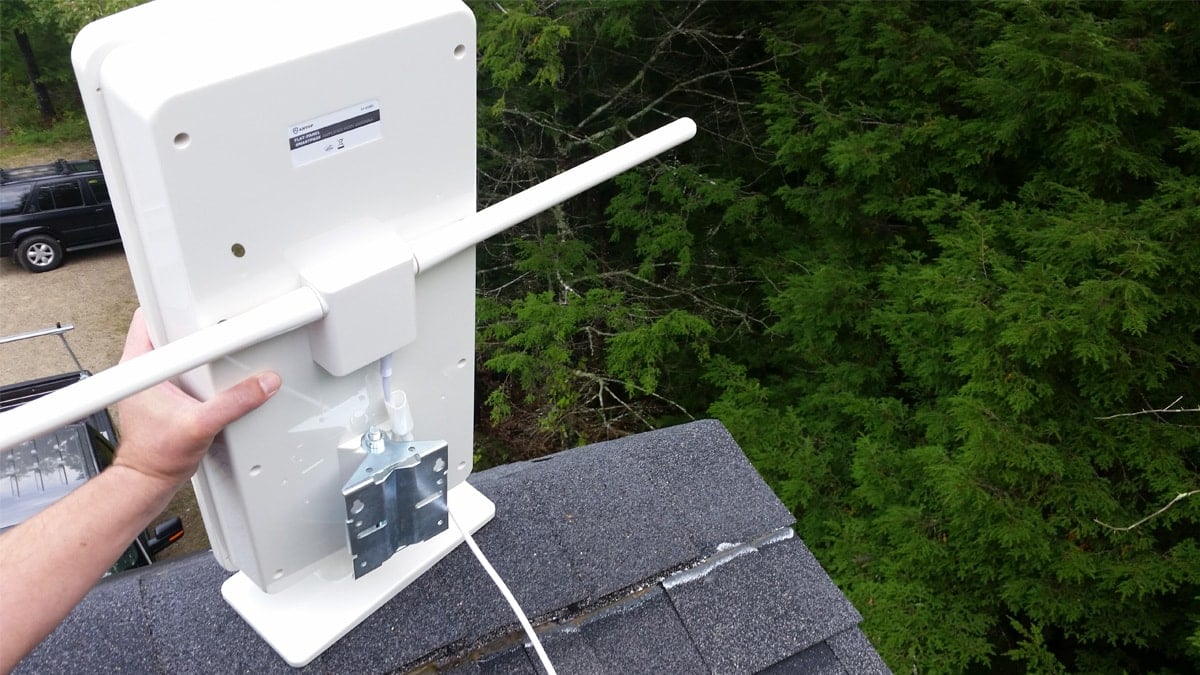Choosing the right TV antenna for your specific location is a crucial first step in ensuring you receive the best possible television signals or reception.
But it’s important to understand that this is only the beginning.
Elevation and correct placement of your TV antenna are equally critical factors that significantly impact the quality of the signal you receive. In the era of cord-cutting, understanding how to effectively use a TV antenna is crucial for accessing free over-the-air digital TV signals.
Table of Contents
Unlike the rabbit ears of the past, today’s antennas are designed to capture digital TV signals.
When your antenna is pointed in the correct direction, and properly mounted, there are a number of channels to watch in most TV markets. They include major broadcasters like ABC, CBS, NBC, Fox, PBS, and sub-channels such as MeTV, GRIT, and CW.
Here’s a step-by-step guide to ensure you get the best reception from your indoor or outdoor TV antenna.
Finding TV Broadcast Towers
To align your antenna for the strongest TV signal, you need to know the direction of local TV transmitters.
Tools like the Antenna Point app, which uses your smartphone’s GPS (latitude and longitude) to locate nearby broadcast towers, can be invaluable.
On the web, you can use the FCC’s DTV Reception Maps tool that shows you what direction to point your antenna based on your zip code.
This step is crucial whether you’re in a bustling city like New York or a more rural area like Maine or Wyoming.
PRO TIP: Remember, the TV antenna signals of today travel by line of sight. They are not like analog signals. And despite what some manufacturers claim, you are not going to get TV signals outside of your TV market.
TV markets are also known as Designated Market Areas (DMAs). By design, antenna signals are designed to not travel beyond your local DMA.
So forget about any TV antenna-maker claiming their antenna has a “250 Mile range.” That’s not going to happen. You might get some local channels from nearby TV towers, but nothing even close to 100 miles.
I have been testing various TV antennas since 2017, and grew up in a household that used rabbit ears on an old Zenith TV. I have climbed on my roof many times in Massachusetts and helped family members in Maine and California with their antenna installs.
Discovering UHF and VHF Signals
Most TV signals are broadcast in either UHF (Ultra High Frequency) or VHF (Very High Frequency).
Most TV stations in the U.S. broadcast on UHF, but VHF is still important in some large markets such as Los Angeles. Understanding which frequencies are predominant in your area can guide your choice of antenna and its direction.
That’s why using the apps and tools mentioned above are an important step in the process.
TV Antenna Reception: Indoor vs. Outdoor
Indoor TV Antennas
- Placement: Ideally near a window or high on a wall or ceiling. Elevation will always help with getting more channels. Avoid placing your flat antenna behind a TV or in a basement.
- Antenna Direction: Point your indoor antenna towards the nearest broadcast towers. Use a compass app on your iOS or Android device for precision.
- Variables: Be mindful of variables like tall buildings or heavy foliage that can impact signal level.
Outdoor TV Antennas
- Elevation and Antenna Direction: Mount your outdoor antenna as high as possible, pointing it in the direction of the TV towers. The higher the antenna, typically the better the performance.
- Coaxial Cable: Use a high-quality coax cable to connect your antenna to your TV, minimizing signal loss.
Related: Discover my Top 7 TV antennas based on my testing.
Multi-directional vs. Directional Antennas
- Multi-directional Antennas: Ideal for receiving signals from multiple directions, especially in urban areas.
- Directional Antennas: Provide the best reception when all broadcast towers are in one direction. They focus on a narrower field, reducing potential interference.
Amplifiers and Non-Amplified Antennas
- Amplified Antennas: Amplifiers should only be used when a TV signal is weak, or you have trouble getting specific channels. Amplifiers do boost weak signals but can also amplify noise. They are best used in areas with low signal strength.
- Non-Amplified Antennas: Suitable for locations with strong signal levels. Avoids the risk of overloading your TV tuner.
Troubleshooting & Recommendations
- Re-scanning for Channels: Always rescan for channels after adjusting your antenna’s direction.
- NextGen TV: While NextGen TV (ATSC 3.0) is emerging, most areas still use ATSC 1.0, which tends to be more stable for now. Based on my testing with NextGen TV so far, most consumers should stick with the current broadcast standard.
- Best Direction: As a cord-cutter, remember that your antenna’s alignment can make a significant difference in the number of available channels and the clarity of your local channels. Face your antenna in the wrong direction and you will be disappointed with its performance.
By following these instructions and understanding the nuances of antenna installation and alignment, you can maximize your TV antenna’s performance. The number of channels you can get will depend on your local TV market.
Taking steps to ensure that you are pointing your antenna in the right direction gives you access to the most broadcast channels possible — without the need for a cable or satellite subscription.

I would like to know how my little flat antenna picks up 15 channels because if you go by line of sight then I should receive nothing because between the tv broadcast station there’s a couple mountains